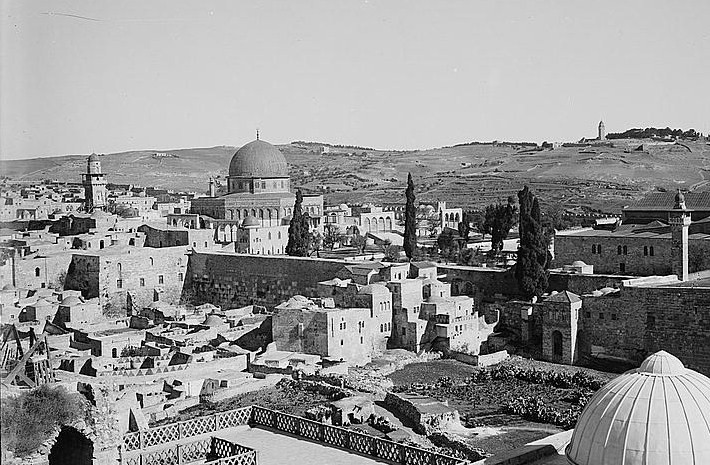The Moroccan community

Palestine, and the city of Jerusalem in particular, has been a destination for Moroccans throughout history; Moroccan pilgrims visiting Mecca and Medina quickly come to the holy city and are attracted to stay there; on the other hand, the city of Jerusalem attracted Moroccan scholars (modernists, scholars, travelers ...); As well as the choice of the Moroccan Mujahideen, who participated in repelling the Crusades, to reside in the city and the rest of the Palestinian areas.

وقد دأب المغاربة على زيارة بيت المقدس منذ ما قبل الاحتلال الفرنجي لمدينة القدس سنة 493هـ/1099م، وتزايدت أعداد المغاربة بعد استرجاع القدس من الفرنجة سنة 583هـ/1187م. وقد ساهم المغاربة في الجهاد الإسلامي ضد الفرنجة؛ وكان لهم دورٌ بارزٌ في فتح بيت المقدس وكسر شوكة الفرنجة في فلسطين؛ ولذلك طلب الناصر صلاح الدين الأيوبي من سلطان المغرب (يعقوب المنصور) مد يد العون وتزويده بأساطيل بحرية تُنازل أساطيل الفرنجة؛ فجهّز سلطان المغرب أسطولًا كبيراً لمساندة الجيش الإسلامي في المشرق العربي.
Moroccans have been visiting Jerusalem since before the Frankish occupation of Jerusalem in 493 Ah/1099 ad, and the number of Moroccans increased after the recapture of Jerusalem from the Franks in 583 Ah/1187 ad. The Moroccans contributed to the Islamic Jihad against the Franks; they had a prominent role in conquering Jerusalem and breaking the fork of the Franks in Palestine; therefore, Nasser Salah al-Din al-Ayyubi asked the Sultan of Morocco (Yaqub al-Mansur) to extend a helping hand and provide him with naval fleets to surrender the Frankish fleets; the Sultan of Morocco equipped a large fleet to support the Islamic army in the Arab Mashreq.
Nasser Salah al-Din al-Ayyubi settled numbers of Moroccans in Jerusalem after the victory of the Muslims in the battles of "Hattin" and"conquest of Jerusalem" over the Franks.
Al – Nasser Salah al-Din said: "there were those who stayed on land and swam in the sea, and the best were those who trusted the Al-Aqsa Mosque and this city"; then the best King, Nur al-Din Abu al-Hassan Ali (the eldest son of Nasser Salah al-Din al-Ayyubi) stopped the hot of the Moroccans on the interests of the Moroccan community residing in Jerusalem during his reign over Damascus (589 Ah/1193-592 Ah/1195 ad) when Jerusalem belonged to him; in order to encourage the people of the Arab Maghreb to come to Jerusalem and and to help its Moroccan residents, who preferred to settle down and adjacent to the blessed Al-Aqsa Mosque. Since that date, this place of the city of Jerusalem has been known as the "Moorish lane".
The Moorish quarter occupied an area of forty-five thousand square meters; thus, it constitutes 5% of the area of Old Jerusalem. The area of the lane has varied according to the difference in its boundaries from time to time; areas of the Moorish lane extended before the Ottoman era to outside the wall; it was known as the"Moorish Brown Lane".

Moroccans have been visiting Jerusalem since before the Frankish occupation of Jerusalem in 493 Ah/1099 ad, and the number of Moroccans increased after the recapture of Jerusalem from the Franks in 583 Ah/1187 ad.
The Moroccans contributed to the Islamic Jihad against the Franks; they had a prominent role in conquering Jerusalem and breaking the fork of the Franks in Palestine; therefore, Nasser Salah al-Din al-Ayyubi asked the Sultan of Morocco (Yaqub al-Mansur) to extend a helping hand and provide him with naval fleets to surrender the Frankish fleets; the Sultan of Morocco equipped a large fleet to support the Islamic army in the Arab Mashreq.
In the first ten years of the British Mandate, Zionism made several attempts to seize the wall and the area of the Moroccan Quarter. After the Nakba of 1948, the majority of the Moroccans of Palestine were forced to take refuge in Syria and Lebanon, and a few of them remained, becoming, like their people, refugees in the world. They stayed in the camps in Lebanon: Tel al-zaatar, Sabra, Shatila, and Burj al-Barajneh; while the majority of those who took refuge in Syria stayed in Yarmouk camp.
Shortly after the occupation of Jerusalem in 1967, the Israeli occupation authorities destroyed the Moroccan neighborhood in the entire city of Jerusalem, razed it to the ground, and turned it into a square called "Weeping Square" to serve Jewish pilgrims and worshippers at the Buraq Wall; at the expense of the established Palestinian historical right in this area; to displace its Palestinian residents of Moroccan origin; where Jewish bulldozers headed to the Moroccan neighborhood within the walls of the city of Jerusalem, demolished it completely, and displaced 135 Muslim families numbering 650 members; also blew up 34 other neighboring houses, and a plastic factory, and displaced about 300 more of its residents and workers. Before it was demolished, there were four mosques, the preference school, and other endowments in Al-Maghriba neighborhood.
A large number of descendants of Moroccan Palestinians still reside in East Jerusalem and other Palestinian areas in the West Bank and the Gaza Strip; among them are families: "Alami"? And the "repairman"? And "rustic", and "Haboush"... Etc. Although there are no exact statistics available for their number in Palestine, according to identical testimonies of a number of them residing in the Gaza Strip and Jerusalem, they are not less than 20 thousand people.
Palestinians of Moroccan origin played an increasing role in the Palestinian National course of action before and after the Nakba; they were distinguished by their national and militant stubbornness, and their unparalleled devotion to the cause of their Palestinian people; martyrs rose from them; the wounded fell from them; and many of them were subjected to captivity during their participation in various Palestinian revolutions and uprisings. The Moroccans have always been respected and appreciated by the people of Jerusalem for their integrity, magnanimity and good neighborliness.
